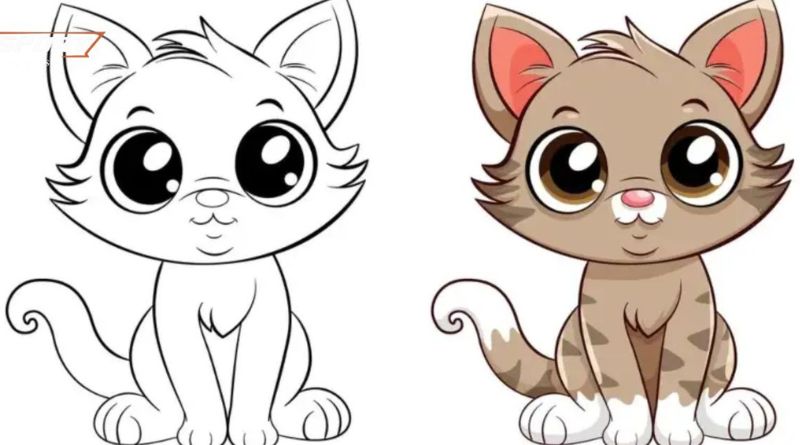Drawing is an expressive and creative form of art, and when it comes to capturing the charm and elegance of a cat, it can be both a rewarding and challenging experience. The code-like title “A4Z_-YMTKR8= Cat” might represent a particular style, method, or a reference for drawing cats, although the exact meaning behind the title may vary depending on its origin. In this guide, we’ll break down the artistic process of drawing a cat, whether you’re a beginner or an experienced artist, and discuss how unique styles and techniques can contribute to different outcomes.
Table of Contents
Understanding the Basics of Drawing a Cat
Cats are known for their sleek, graceful bodies, sharp features, and expressive eyes. When drawing a cat, capturing these characteristics is essential to create a lifelike or stylized version of the animal. Here are the basic steps to get you started:
1. Start with Basic Shapes
- Begin by sketching the basic shapes that make up the cat’s body: an oval or circle for the head, a larger oval for the torso, and smaller circles or lines for the limbs and tail.
- This step allows you to proportion the cat correctly and serves as a foundation for adding details later.
2. Outline the Head and Facial Features
- After establishing the basic shape of the head, add guidelines to indicate where the eyes, nose, and mouth will be placed. Cats have distinctive almond-shaped eyes and triangular noses, which are key to capturing their likeness.
- Focus on the symmetry of the face, especially the distance between the eyes and the alignment of the nose and mouth.
3. Add the Cat’s Ears and Tail
- Cats have pointed ears that sit on top of their head, so make sure to position them appropriately. The ears can be slightly curved depending on the cat’s pose or expression.
- The tail can be long and curled or straight, depending on the cat’s posture and mood. Use flowing lines to depict its natural movement.
4. Define the Body and Legs
- Using the oval and circle guidelines you created earlier, start fleshing out the body by connecting them with smooth lines. Pay attention to the graceful curve of a cat’s back and the slenderness of its legs.
- Cats’ legs are relatively thin with small paws. You can add more definition by showing the muscles and joints.
5. Focus on Fur Texture
- Cats come in a variety of fur types, so deciding on whether your cat will have short, sleek fur or long, fluffy fur will impact how you draw it. Use light strokes to add texture and depth, layering lines to mimic the direction and thickness of the fur.
6. Refine and Add Details
- Once you have the basic shape and structure down, start refining your drawing. Add the pupils to the eyes, whiskers, and any additional details like spots, stripes, or shading to make your cat more realistic or stylized.
7. Shading and Lighting
- To give your drawing dimension and a sense of realism, shading is crucial. Decide where the light source is coming from, and darken the areas that are in shadow. This will give your cat a three-dimensional appearance.
- You can use different pencil grades (hard or soft) for various effects, from fine details to deep shadows.
Common Styles for Drawing Cats
There are many ways to draw a cat, and your choice of style will affect the overall look of the drawing. Here are a few popular styles:
- Realistic: Aimed at capturing every fine detail of the cat’s anatomy, fur, and features. This style is more intricate and takes time to perfect.
- Cartoon/Anime: Simplified and exaggerated, with bold outlines, large eyes, and minimal shading. This style is popular for illustrations and animations.
- Abstract: Instead of aiming for a realistic representation, this style focuses on shapes, lines, and colors to capture the essence of a cat. This can be more expressive and open to interpretation.
- Minimalist: Uses few lines and simple shapes to represent the subject. This style is effective for creating striking, simple drawings that leave more to the viewer’s imagination.
Importance of Practice
Drawing a cat, or any animal, takes practice and patience. Don’t worry if your first few attempts don’t turn out perfect—experimenting with different techniques and styles will help you improve over time. Try to study references, whether real-life cats or images, to understand their anatomy and behavior.
FAQs
1. What is the meaning of A4Z_-YMTKR8= in cat drawing?
The meaning behind “A4Z_-YMTKR8=” is unclear and may refer to a specific style, method, or even a digital code used to classify different types of drawings. Without further context, it could be a reference from a particular drawing community or artist.
2. How do I make my cat drawing look more realistic?
To make your drawing more realistic, pay attention to proportion, shading, and texture. Use reference images, focus on details like fur direction and shadows, and take your time refining the features such as the eyes, nose, and mouth.
3. What materials do I need to draw a cat?
You’ll need basic materials like pencils, erasers, and paper to get started. For more advanced drawings, you may want to use shading tools like blending stumps, or even colored pencils or digital drawing software.
4. How can I improve my drawing skills?
Practice regularly, study real-life references, and experiment with different styles and techniques. You can also follow tutorials or join drawing communities to get feedback and inspiration.
5. Is it better to draw a cat from memory or use a reference?
While drawing from memory can be fun, using references will help you capture more accurate details and improve your understanding of anatomy and proportions.
Conclusion
Drawing a cat can be an enjoyable and creative experience, whether you’re aiming for realism or a more stylized approach. By following basic steps and practicing regularly, you’ll be able to capture the grace and beauty of these fascinating animals. Regardless of the style or method you choose, each drawing is a unique expression of your creativity.



